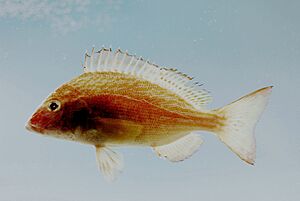Pigfish facts for kids
Quick facts for kids Pigfish |
|
|---|---|
 |
|
| Conservation status | |
| Scientific classification |
The pigfish, also known as the hogfish, piggy perch, redmouth grunt, or sailor's choice, is a type of fish found in the western Atlantic Ocean. It belongs to a group of fish called grunts. These fish get their name because they can make a grunting or chattering sound. They do this by rubbing special teeth in their throats together.
Contents
What Does a Pigfish Look Like?
The pigfish has a body shaped like an oval, and it's a bit flat from side to side. Its mouth is small with thin lips and doesn't reach its eyes. Inside, its mouth is not red. It has a narrow band of small teeth in its jaws.
Its top fin (dorsal fin) has 12 or 13 sharp spines and about the same number of soft rays. The fin underneath (anal fin) has 3 spines and 12 or 13 soft rays. The second spine on this fin is a little thicker and longer than the third.
Almost its whole body is covered in scales, except for the very tip of its nose, its lips, and its chin. The pigfish is usually pale bluish-grey on its back and silvery underneath. Each scale on its body has a blue center and a bronze spot on the edge. These spots create cool diagonal orange-brown stripes that run along its sides and back. The stripes below its middle line are straight. Its head has bronze spots, and its fins are yellowish-bronze with darker edges.
A pigfish can grow up to about 46 centimeters (about 18 inches) long, but most are around 30 centimeters (about 12 inches). The heaviest pigfish ever recorded weighed about 900 grams (about 2 pounds).
Where Do Pigfish Live?
Pigfish live in the western part of the Atlantic Ocean. You can find them from Massachusetts in the north, all the way down the Atlantic coast of the United States, around Florida, and into the Gulf of Mexico. This includes places like the Yucatan Peninsula and Cuba. They are also found near Bermuda. Sometimes, they might even travel far, like one that was seen off Sicily in 2020, probably carried there by a ship.
Pigfish Homes and Habits
Pigfish like to live in shallow waters, usually between 1 and 20 meters (about 3 to 65 feet) deep. They can be found in estuaries (where rivers meet the sea) and bays. Sometimes they swim into canals, but they avoid water that isn't salty enough.
They aren't picky about where they live in these shallow areas. You can find them over soft bottoms like sand or mud, or on hard surfaces like jetties, reefs, and even oil rigs. They also like areas with shell banks. They live both close to the coast and further out on the continental shelf.
Pigfish Life Cycle
Pigfish mostly lay their eggs in the spring, starting in late winter. Larger fish tend to lay their eggs earlier. After laying eggs, the fish become a bit weaker. Spawning happens at dusk (evening). The eggs and young larvae float in the water. Eggs hatch after about 48 hours. The young fish become juveniles when they are about 7 centimeters (about 2.7 inches) long. Pigfish can live for about 4 years, but most only live for 3 years.
What Do Pigfish Eat?
Pigfish are hunters! They come out from their hiding spots to find food at night. They mostly eat small creatures that live on the seafloor, like worms, small crabs, and snails. As a pigfish grows bigger, it eats bigger prey. Younger pigfish mostly eat tiny floating crustaceans (like mini shrimp). Larger pigfish eat more worms, bigger crustaceans, mollusks (like clams), and even smaller fish. They have also been seen eating insect larvae in brackish (slightly salty) water.
Pigfish travel to different areas. They move offshore (further out to sea) when the water gets cold. When they return closer to shore in the spring, they are often not in great shape, which suggests that food offshore might not be as good. They also make shorter daily trips between their feeding areas and their shelters.
The pigfish probably got its common name because of the chattering noises it makes when caught. Like other grunts, they make this sound by rubbing their throat teeth together. When they are eating, pigfish use these same throat teeth to grind up shellfish and other small food bits.
How People Use Pigfish
People catch pigfish using fishing rods, traps, and large nets called seines. The exact number of pigfish caught isn't always recorded separately from other fish. Their meat is usually sold fresh to eat. Pigfish are also often caught to be used as bait for catching other, larger fish, like the spotted sea trout.


